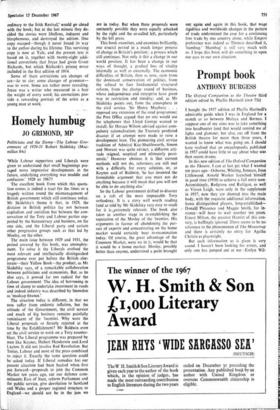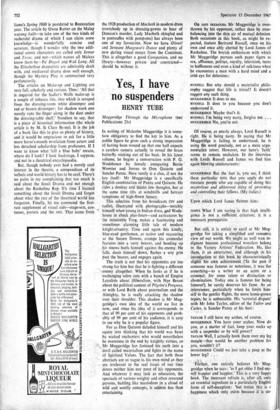Prompt book
ANTHONY BURGESS
The Oxford Companion to the Theatre third edition edited by Phyllis Hartnoll (oue 75s) I bought the 1957 edition of Phyllis Hartnolf's admirable• guide when I was in England for a month or -so between Malaya and Borneo. I suppose one, of my aims was to take something into headhunter land that would remind me of lights and glamour, but also, cut off from the British theatre for more than three years, I wanted to know what was going on. I should have realised that an encyclopaedia published in 1957 could have little to say about what was then recent drama.
In this new edition of The Oxford Companion to the Theatre. I can at last get what I wanted ten years ago—Osborne, Whiting, Ionesco, Join Littlewood. Arnold Wesker launched himielf in good time (1958) to achieve a full entry now. Astonishingly, Redgrave and Rattigan, as well as Vivien Leigh, were only in the supplement in 1957; noir they are shunted into the main body, with the requisite additional information. Some distinguished players, long-established— Donald Pleasence and Maggie Smith, for in- stance—will have to- wait another ten -years. Ernest Milton, the greatest Hamlet of this cen- tury, is bafflingly ignored. There seems to be no reference to the phenomenon of The Mousetrap and there is certainly no entry for Agatha Christie-as playwright.
But such information as is given is very sound. I haven't been looking for errors, and only one has jumped out at me—Emlyn Wil- year. The article by Owen Rutter on the Malay wayang kulit—to take one of the two kinds of recherche drama of which I can claim some knowledge—is wonderfully concise and accurate, though I wonder why the two addi- tional comic characters are called only Semar and Turas, and not—which names all Malays know them by—Pa' Dogok and Wak Long. All the Elizabethan dramatists are admirably dealt with, and mediaeval drama does well enough, though the Mystery Play is summarised very perfunctorily.
The articles on Make-up and Lighting are very full, scholarly and curious. Thus: 'All that is required for the Sadler's Wells make-up is a couple of tobacco tins, into which is scraped from the dressing-room white distemper and red or brown distemper: for shadow work one merely runs the finger along in the dust under the dressing-table shelf.' Needless to say, that is a piece of historical information (the whole article is by M..St Clare Byrne). It is the job of a book like this to give us plenty of history, and it would be ungracious to ask for a little more horse's-mouth revelation from actors and less detached scholarship from professors. If I want to know what Till a Lillie baby' means, where do I look? I look backstage, I suppose, and not in a theatrical encyclopaedia. But, though nobody ever had a merely cool interest in the theatre, a compendium of its technic and world history has to be cool. There's no point in my comPlaining.that too much is said about the Jesuit Drama and not enough about the Rusholme Rep. It's time I learned something about the Jestiit DraMa and forgot about what the rest of the theatrical world his forgotten. Finally, let me commend the first- rate supplement of visual aids:--stage-sets, cos- tomes, posters and the rest. That scene _froth
the 1928 production of Macbeth in modern dress (everybody up in dressing-gowns to hear of Duncan's murder, Lady Macbeth shingled and in pantoufles with pompoms) has always been one of my favourites. Now we have Oliver! and Serjeant Musgrave's Dance and plenty of new daring visual essays from the Continent. This is altogether a good Companion, and no library—however private and - constricted— should be without it.



































 Previous page
Previous page